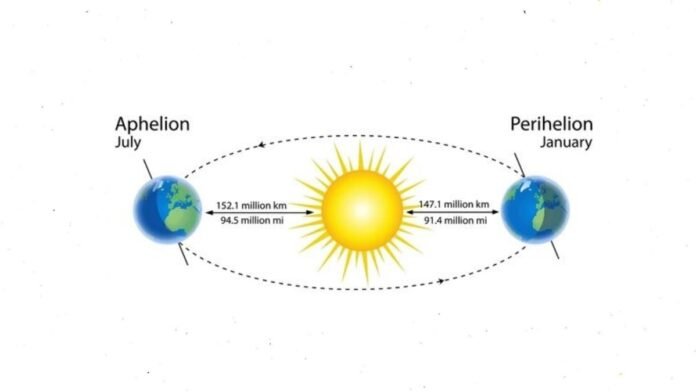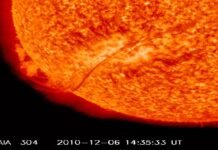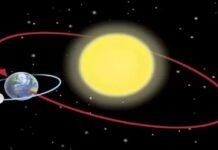
Key Points
- On July 4, 2025, Earth will reach its farthest point from the Sun, known as “aphelion,” at about 152.1 million km (1.0166 AU) away.
- This rare event causes the Sun to appear slightly smaller in the sky than usual.
- Earth’s orbit is elliptical, leading to varying distances from the Sun throughout the year.
- The closest approach of the Moon to Earth, called “perigee,” will occur on July 20, making the Moon appear larger and brighter.
- These events offer unique opportunities for astronomers, students, and sky enthusiasts to observe and learn about celestial mechanics.
New Delhi: A celestial spectacle awaits astronomy enthusiasts as Earth reaches its farthest point from the Sun known as “aphelion” on July 4, 2025. This rare event, occurring once a year, offers a fascinating glimpse into the mechanics of our solar system and is a golden opportunity for anyone curious about the universe.
What is Aphelion?
Earth’s orbit around the Sun is not a perfect circle but an ellipse, meaning our distance from the Sun changes throughout the year.
- Aphelion is the point at which Earth is farthest from the Sun.
- This year, on July 4, Earth will be approximately 152.1 million kilometers (1.0166 astronomical units) from the Sun.
- As a result, the Sun will appear slightly smaller in the sky than at other times of the year.
Why Does This Happen?
The elliptical nature of Earth’s orbit means:
- Closest approach to the Sun (called “perihelion”) happens in early January, when the Sun appears largest.
- Farthest distance from the Sun (aphelion) occurs in early July, making the Sun look a bit smaller to the naked eye.
Moon’s Closest Approach: Perigee on July 20
The astronomical excitement doesn’t end there!
- On July 20, 2025, the Moon will reach its perigee, the closest point to Earth in its orbit.
- This will coincide with a nearly full Moon, making it appear larger and brighter in the night sky a phenomenon often called a “Supermoon.”
What Can You Observe?
- On July 4: Look for the Sun at its smallest apparent size (though never look directly at the Sun without proper protection).
- On July 20: Watch for a noticeably larger and brighter Moon, especially at moonrise and moonset.
Why Are These Events Important?
- These celestial events are perfect opportunities for students, amateur astronomers, and curious minds to learn about the dynamics of our solar system.
- They demonstrate the delicate balance and predictable patterns that govern planetary and lunar motions.
- Such events also remind us of the vastness and wonder of the universe, sparking curiosity and scientific inquiry.
How to Enjoy the Events
- Use solar filters or projection methods to safely observe the Sun’s size change.
- For the Supermoon, simply step outside after sunset on July 20 and enjoy the view no special equipment needed!
Mark your calendars for July 4 and July 20, 2025, and don’t miss these rare and beautiful moments in the sky! For more tips on skywatching and astronomy news, stay tuned to our updates.
Advertisement


















































